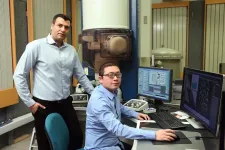(Press-News.org) How are networks of neurons connected to make functional circuits? This has been a long standing question in neuroscience. To answer this fundamental question, researchers from Boston Children's Hospital and Harvard Medical School developed a new way to study these circuits and in the process learn more about the connections between them.
"Neural networks are extensive, but the connections between them are really small," says Wei-Chung Allen Lee, PhD, of the F.M. Kirby Neurobiology Center at Boston Children's and Harvard Medical School. "So, we have had to develop techniques to see them in extremely high-resolution over really large areas and volumes." To do so, his team developed an improved process for large-scale electron microscopy (EM) -- a technique first developed in the 1950s using accelerated electrons beams to visualize extremely small structures.
"But the problem with electron microscopy is that because it provides such high image resolution, it has been difficult to study whole neural circuits," says Lee, whose lab is interested in learning how neural circuits underlie function and behavior. "To improve the technique, we developed an automated system to image at high-resolution, but at the scale to encompass neuronal circuits." A paper describing this work was published in Cell.
GridTape: Automated, Faster, Cheaper Electron Microscopy Technique
Traditional EM requires hand collection of thousands of tissue samples onto a grid. The tissue is sliced in 40 nanometer-thick sections, about a thousand times thinner than a human hair. The technique automates collection of the samples, assigning a barcode to each section, and applying them to a conveyor belt that could then be fed through an electron microscope like a movie projector. An advantage of the technique is that every neuron is labeled in each tissue section.
"As the electrons pass through each section, we can image each neurons in fine detail," Lee explains. "And because all of the sections are labeled with a barcode we know exactly where each of these sections comes from so we can reconstruct the circuits."
"This new technique allows us to do electron microscopy faster and in an automated way, with high quality, yet at a reasonable price," says Lee.
In their paper, the team provides GridTape instrumentation designs and software to make large-scale EM accessible and affordable to the larger scientific research community.
Fruit fly spinal cord: a case study
The team used their GridTape method to study the ventral nerve cord of the Drosophila melanogaster fruit fly, which is similar to the spinal cord. It contains all the circuits the fly uses to move its limbs. Their goal: create a comprehensive map of the neuronal circuits that control motor function.
"By applying this method to the entire nerve cord, we were able to reconstruct all of its motor neurons, as well as a large population of sensory neurons," says Lee.
In the process, they discovered a specific kind of sensory neuron in the fly thought to detect changes in load, like body weight. "These neurons are very large, relatively rare in number, and they make direct connections onto motor neurons of the same type on both sides of the body," says Lee. "We believe this may be a circuit that helps stabilize body position."
From this work, the team created a map of more than 1,000 motor and sensory neuron reconstructions available on an open registry. "It allows anyone in the world to access this data set and look at any neuron that they're interested in and ask who they're connected to," says Lee.
Future applications
Now with the ability to map ever larger neural circuits, Lee believes this technique could be useful for studying neuronal circuits in larger brains and testing predictions about neural function and behavior. His team is now studying the technique in mice and other researchers in the UK and Japan are applying the technique across multiple animal systems.
In addition, the technology has broader potential uses where large numbers of samples need to be imaged at a very high resolution.
"So, in principle, various forms of electron microscopy could be advanced by using this technique if people need to generate lots and lots of data," says Lee, including DNA sequencing using EM, or cryogenic EM to solve protein structures.
INFORMATION:
Contributing authors to this work include co-first authors Jasper S. Phelps, David G. C. Hildebrand, and Brett J. Graham of Harvard Medical School, along with Aaron T. Kuan, Logan A. Thomas, Tri M. Nguyen, Mingguan Liu, and Brendan L. Shanny of HMS; Julia Buhmann and Jan Funke of HHMI; and Anthony W. Azevedo, Anne Sustar, Sweta Agrawa, and John C. Tuthill of University of Washington, Seattle.
ORLANDO, Jan. 11, 2021 - Data from Arecibo Observatory in Puerto Rico has been used to help detect the first possible hints of low-frequency disturbances in the curvature of space-time.
The results were presented today at the 237th meeting of the American Astronomical Society, which was held virtually, and are published in The Astrophysical Journal Letters. Arecibo Observatory is managed by the University of Central Florida for the National Science Foundation under a cooperative agreement.
The disturbances are known as gravitational waves, which ripple through space as a result of the movement of incredibly massive objects, such as black holes orbiting one another or the collision of neutron stars.
It's important to understand these waves as they provide insight into the history ...
CAMBRIDGE, MA -- When we experience a new event, our brain records a memory of not only what happened, but also the context, including the time and location of the event. A new study from MIT neuroscientists sheds light on how the timing of a memory is encoded in the hippocampus, and suggests that time and space are encoded separately.
In a study of mice, the researchers identified a hippocampal circuit that the animals used to store information about the timing of when they should turn left or right in a maze. When this circuit was blocked, the mice were unable to remember which way they were supposed to turn next. However, disrupting the circuit ...
North Carolina State University-led researchers have developed an analytical measurement "framework" which could allow organic solar cell researchers and manufacturers to determine which materials will produce the most stable solar cells prior to manufacture.
Organic solar cells have increased in efficiency over the past decades, but researchers and manufacturers still struggle with determining which material combinations work best and why, as well as with achieving stable morphology and operation.
"There is still a lot of 'trial and error' guesswork involved in identifying promising materials for these solar cells," says Harald Ade, Goodnight Innovation Distinguished Professor of Physics at NC State and co-corresponding author of the research. ...
Two studies in today's Nature Neuroscience, led by researchers at Boston Children's Hospital, Brigham and Women's Hospital (BWH), and Harvard Medical School (HMS), implicate mosaic mutations arising during embryonic development as a cause of autism spectrum disorder (ASD). The findings open new areas for exploring the genetics of ASD and could eventually inform diagnostic testing.
Mosaic mutations affect only a portion of a person's cells. Rather than being inherited, they arise as a "mistake" introduced when a stem cell divides. A mutation in a stem cell will only be passed to the cells that descend from it, producing the mosaic pattern. ...
Reza Shahbazian-Yassar, professor of mechanical and industrial engineering at the University of Illinois Chicago.
Shahbazian-Yassar and colleagues facilitated the development of a cutting edge "Swiss Army knife" catalyst made up of 10 different elements - each of which on its own has the ability to reduce the combustion temperature of methane - plus oxygen. This unique catalyst can bring the combustion temperature of methane down by about half - from above 1400 degrees Kelvin down to 600 to 700 degrees Kelvin.
Their findings are reported in the journal Nature Catalysis.
In previously-published research, ...
Tales of post-apocalyptic landscapes in which few survivors emerge into a new and much different world have long been popular tales woven by screenwriters and authors. While many enjoy these stories, thinking of them as nothing but a guilty pleasure, they may not realize that immersing themselves in fiction has prepared them for the reality of 2020, according to a team of researchers.
John Johnson, professor emeritus of psychology at Penn State, recently conducted research with several colleagues revealing that an individual's enjoyment of horror films could have better prepared them for the COVID-19 pandemic as opposed to others who do not enjoy frightening entertainment. Their findings are documented in Personality and Individual Differences.
"My latest ...
The first-ever study of the levels of the stress hormone cortisol in the saliva of newborn white-tailed deer fawns yielded thought-provoking results that have Penn State researchers suggesting predation is not the only thing in the wild killing fawns.
"We think the hormone offers a way to evaluate factors in the environment that affect fawns, such as disease, but are difficult to evaluate when just looking at a carcass that has been picked over by predators," said researcher Duane Diefenbach, adjunct professor of wildlife ecology. "By then, it's impossible to be certain what ...
University of Wyoming researchers headed a study that shows nonnative birds in Oahu, Hawaii, have taken over the role of seed dispersal networks on the island, with most of the seeds coming from nonnative plants.
"Hawaii is one of the most altered ecosystems in the world, and we are lucky enough to examine how these nonnative-dominated communities alter important processes, such as seed dispersal," says Corey Tarwater, an assistant professor in the UW Department of Zoology and Physiology. "What we have found is that not only do nonnative species dominate species ...
Boston, Mass. - As the number of COVID-19 infections continues to rise nationwide, more than 360,000 Americans have already died from the potentially deadly viral infection. But recent reports describe an increase in mortality during the pandemic that cannot be explained by COVID-19 deaths alone.
In a new study from the Richard A. and Susan F. Smith Center for Outcomes Research in Cardiology at Beth Israel Deaconess Medical Center (BIDMC), researchers analyzed data from the National Center for Health Statistics to compare the rate of cardiovascular-related deaths before and after the onset of the pandemic in ...
Mindfulness courses can reduce anxiety, depression and stress and increase mental wellbeing within most but not all non-clinical settings, say a team of researchers at the University of Cambridge. They also found that mindfulness may be no better than other practices aimed at improving mental health and wellbeing.
Mindfulness is typically defined as 'the awareness that emerges through paying attention on purpose, in the present moment, and nonjudgmentally to the unfolding of experience moment by moment'. It has become increasingly popular in recent years as a way of increasing wellbeing and ...



